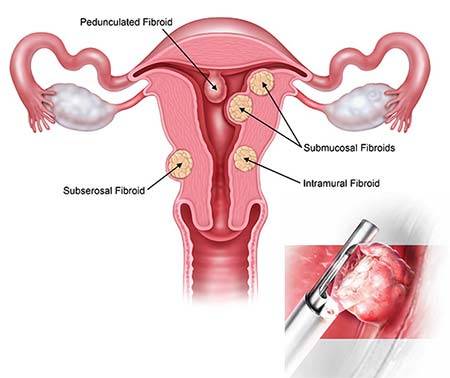What Is Myosure Fibroid and Polyp Removal Procedure?
 Uterine fibroids and polyps can form on the tissue of your uterine. If left untreated, they can cause:
Uterine fibroids and polyps can form on the tissue of your uterine. If left untreated, they can cause:
- infertility
- abdominal pain
- irregular bleeding
- lengthy, heavy periods
In the past, treatment included hysterectomy, but today, there are better, faster, and cheaper alternatives, including the Hologic Myosure tissue removal system.
Approved by the U.S. Food and Drug Administration in 2009, the Myosure procedure safely removes fibroids and polyps without cutting your skin or subjecting you to general anesthesia.
Best of all, our gynecologists can perform the procedure in New York City on the Upper East Side and Midtown, Manhattan, usually within a half-hour. The result leaves your uterus intact while resolving the causes of your symptoms. Of course, you should always be evaluated with a thorough consultation and examination by a physician for an accurate diagnosis and treatment plan. It may be a symptom or sign of a severe illness or condition.
What Are the Symptoms of Polyps vs. Fibroids?
Most women know what a polyp is if they know anyone who’s been through a colonoscopy. Polyps are excess tissue that sprouts from the inner lining of your uterus. These polyps form small oval or round balloons attached to the uterine lining by a thin stem, like polyps in your colon. They don’t get more prominent than a golf ball and are usually much smaller.
Most often, polyps appear in older women who have reached a postmenopausal or perimenopausal age.
If you’re feeling abdominal pain and heavy periods, you may have uterine fibroids since polyps aren’t known to cause much pain. On the other hand, fibroids are composed of hard muscle that grows from your uterine muscular layer. And while fibroids can stay small, they can become much more prominent than polyps — as large as a watermelon.
Both fibroids and polyps form from hormonal imbalances. Both interfere with conception, similar to an intrauterine device. In addition, Fibroids often cause pain, while polyps often lead to bleeding and spotting. But both can be removed using the Hologic Myosure procedure.
Removing Uterine Growths
The Myosure tissue removal system represents a leap forward for removing polyps and fibroids from your uterus. It’s a smaller tool, which requires less dilation, increases precision, and eliminates the need for general anesthesia. Your surgeon can perform the procedure right in the center for gynecology without a hospital visit. The entire process can take as little as 30 minutes.
Using the Hologic Myosure system, our doctors can remove the tissue causing you pain and bleeding. Your doctor doesn’t need to cut through your skin anywhere, and a local anesthetic suffices for controlling any pain. In addition, the procedure leaves your uterus intact and doesn’t disrupt your menstrual cycle or hormone production.
Our gynecologists follow three steps to complete the procedure:
- First, the doctor inserts a tiny camera through your vagina, past your cervix, and into your uterus.
- Using the images from the camera, your gynecologist then inserts a thin tool into your uterus that cuts away the polyps and fibroids found there. Finally, your doctor suctions the cut tissue away.
- The doctor inspects your uterus to ensure that no polyps or fibroids are remaining. Then the performing surgeon withdraws the tool and camera.
Who Are Candidates for the Myosure Procedure?
The starting point is getting an accurate diagnosis. If your gynecologist can rule out other causes of your abnormal bleeding or abdominal pain, a Myosure procedure could be appropriate for you. However, you should always be evaluated with a thorough consultation and examination by a physician for an accurate diagnosis and treatment plan. It may be a symptom or sign of a severe illness or condition.
You should discuss these factors and others with your physician.
The Myosure tissue removal system lets your gynecologist perform a myomectomy to remove fibroids or a polypectomy to remove polyps from your uterus.
After the anesthetic wears off following your Myosure procedure, you may feel lightheaded to the point of nausea, and you may feel some cramping. These are normal reactions and aren’t dangerous. A woman rarely suffers side effects or complications from this procedure.
Keep in mind that everyone recovers at a slightly different rate. You may bounce back quickly or need a few extra days. Your ability to recover depends on your condition before the procedure, as well as how closely you follow your Midtown gynecologist’s post-procedural instructions. In general, you’ll need a day or two before you can return to your regular schedule.
Give your body about three months to heal fully. You can and should monitor your menstrual cycle, but be aware that you may need those three months to get back to your normal rhythm. It would help if you did not experience any severe pain during this period. You should discuss any issues that you are having with your gynecologist.
All symptoms should always be evaluated with a thorough consultation and examination by your gynecologist for an accurate diagnosis and treatment plan to exclude any serious underlying condition.
The Hologic Myosure tissue removal system has proven to be a safe and successful treatment for removing polyps and fibroids from your uterus. The procedure is fast, and the recovery time is quicker than other alternatives, including a full-fledged hysterectomy. In addition, the size of the hysteroscopic tool means your gynecologist can find and remove polyps as small as 2.5 millimeters.
But the first step is an accurate diagnosis of what’s causing your pain, infertility, or irregular bleeding. Contact your gynecologist today.
All symptoms should always be evaluated with a thorough consultation and examination by your gynecologist for an accurate diagnosis and treatment plan to exclude any serious underlying condition.
Have questions about the Myosure Fibroid & Polyp Removal Procedure? Schedule an appointment with one of the top NYC Gynecologists today!